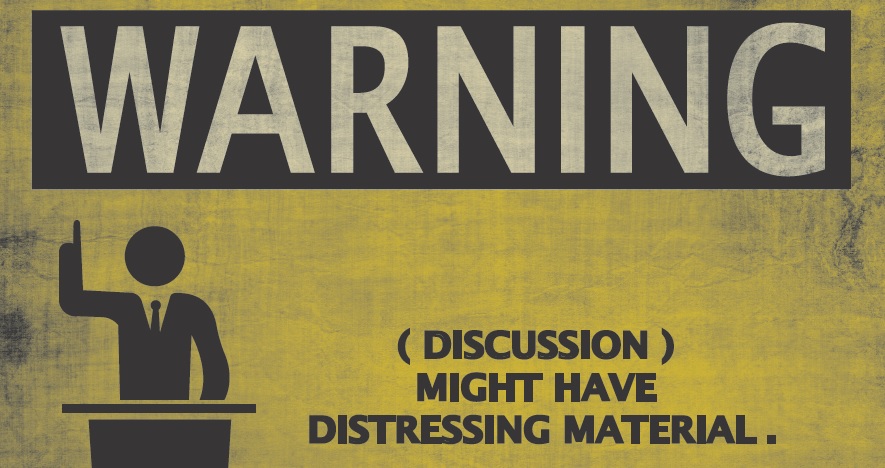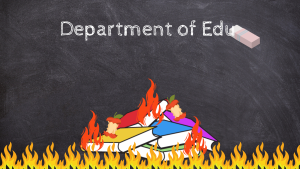[tabs tab1=”Eric Hilton” tab2=”Amanda Hughes”]
[tab id=1]

Trigger Warning: this piece contains the opinions of a privileged white male and may differ from or even outright offend your own. Individuals who are unable to handle differences in perspective should not read this article. Please proceed with caution.
Every time I step outside, someone, somewhere, has found yet another way to ensure that I am not offended.
Signs around campus keep me constantly reassured that Rollins is a safe place where people from a wide array of backgrounds can come together and discuss their opinions in a nurturing environment. Emails remind me daily that Rollins is a protected zone and nobody should feel left out.
Yet somehow this is not enough, and to properly ensure that every person is fully respected in every regard all the time, some students believe that trigger warnings should be implemented.
For those unaware, a trigger warning’s purpose is to cater to individuals who have trauma related to a past incident. Yet, through the power of the internet, trigger warnings have been transformed into a means to protect people from anything that might offend them.
Trigger warnings are a slippery slope. What happens when they are applied to social interactions?
Should I spend 15 minutes warning my friends about the ingredients in my sandwich in case one of them is vegetarian? If one of my triggers is green grass, do I have a right to have Mills Lawn painted orange? Perhaps I could just not talk about anything I like or enjoy in order to avoid offense.
And what happens when I use a trigger warning but still end up offending someone? Does that person have a right to bring criminal charges for making them upset?
More importantly, how do we regulate trigger warnings in the classroom? Math and science teachers should get out okay, but what about the humanities? History teachers would have to a give a five hour trigger warning speech before even starting a lesson on WWII.
The purpose of college is to get outside of your comfort zone and meet people with perspectives that differ from yours.
Asking Rollins to design regulations and rules to protect you from being offended is childish. This is Rollins College, not Rollins Elementary.
[/tab]
[tab id=2]
It is a misconception that trigger warnings are the bane of free speech. As the real world becomes scarier, people often wonder, “Why do I have to censor myself?” In reality, trigger warnings are a better alternative to censorship: the speaker can deliver their message while ensuring their audience consists of people who are receptive.
Confusing? It shouldn’t be. Trigger warnings are short verbal or printed notifications that a presentation or other work may contain “triggering” material—that is, words or stories that might cause a negative emotional reaction in some people—and allow people to choose whether or not to engage with that material. Trigger warnings allow people who would rather not listen to leave. The speaker then continues with the topic.
Self-proclaimed crusaders are currently criticizing college campuses for using what they say is an overabundance of trigger warnings. Common arguments include, “Why coddle new adults?” and “They will have to face the real world sooner or later, right?” and “We didn’t have trigger warnings when we were in school!” Opponents to trigger warnings fail to realize that developing new tactics to improve quality of life is what humanity has been doing since its beginning.
Incoming freshmen received a trigger warning at the beginning of Title IX training, where they were notified that sensitive subjects such as rape and domestic abuse would be discussed. That warning took 10 seconds to deliver, but it could have saved days of recovery time for victims of violent assault.
Other foes fear that trigger warnings are too pervasive and interruptive, but the beauty of a trigger warning is that the warning happens at the start of a presentation. Just like a fire alarm does not continue to ring after the blaze has been put out, trigger warnings are not needed in every sentence of an article or every page of a website. One indication at the beginning does the job just fine.
The truth is, we can never know what the person right next to us has been through. If there is a small, gracious thing we can do to help a fellow student, it is to prevent them from reliving the trauma they have struggled so desperately to leave behind them.
“But, wait,” challengers cry, “What about when those people enter the real world? Nobody’s going to look out for them there!”
Newsflash: This is the real world.
Now, that argument, though usually poorly worded, may have some truth; as someone who lives with a mental disorder, I can testify that there are situations in which I must work with people who are insensitive to my discomfort. For every 10 people who are blind to my boundaries, there may only be one person who is thoughtful enough to give me a warning before jumping into subjects hard for me to cope with. Here is the thing: I tolerate working with the oblivious people, but I treasure working with the one considerate soul.
Survivors are strong. They are going to be fine in the big, scary “real world.” But the real world is just a large group of people who decide every day how they are going to interact with each other. How much harder is it for coworkers, friends, and, yes, campuses to take that extra step of kindness for someone else? Why is it such a burden to show courtesy and respect, and why does being thoughtful mean endorsing weakness?
It is time for campuses to support students from all walks of life. Trigger warnings, when concise and appropriately used, allow students to avoid stress and focus on the most important facet of college life: education.
[/tab]
[/tabs]







Be First to Comment